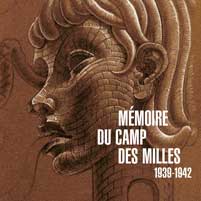
Too fine to be left in oblivion
Angelika Gausmann Sociologist of art
Because art extends far beyond the material of its creation and because its form is the work of the mind and emotions and will remain and be handed down over time, it is the most lasting way of leaving some trace behind oneself, traces of one’s personal story and history, as well as those of History itself, as is the case for what the artists in the Camp des Milles have left us.
The tile factory at Les Milles – this place where thousands of refugees were interned and more than two thousand of them, i.e. those Jews considered to be foreigners, deported to the gas chambers of Auschwitz during the summer of 1942 – remains in people’s minds because works of art were actually created there. The murals described by Christa Wolf in Transit : Ortschaften were made in the guards’ refectory. Since then they have become the symbol for internment and deportation in the South of France and an authentic testimony from the human beings who were interned there. To deny testimonies of this kind is to deny the genius loci and French collaboration with the Germans during the Holocaust.
In his Sociology of Art, Hans Peter Thurn notes that as the essence of the socio-cultural environment in which they were created, works of art take on symbolic power. Painters, sculptors and illustrators were deeply immersed in the very heart of their subject matter and its reality – life in the camp – that naturally provided the source of their creative art. Once the camp was established, an intense cultural life organised by the prisoners amongst themselves was soon set up around the many artists and writers interned there. From the autumn of 1939, the group of artists formed by Gert Caden, Robert Liebknecht and Peter Lipman-Wulf met regularly in the catacombs, whilst the YMCA group and Karl Bodek, who gave drawing lessons in the camp, began to leave their imprint on cultural life there from 1940 right up to the first deportations.
Leo Maillet (1902-1990) was able to save two of his own drawings, invaluable in documentary terms, by jumping off the train deporting him. He managed to survive in spite of his serious injuries and the loss of his left eye. By now it was only through the themes tackled or what their work suggested that artwork done on paper in situ still referred to life in the Camp des Milles. With one of his rubbings on files used in the former factory, Max Ernst even managed to create the 20th century masterpiece, Stateless, out of his Loplop, a defenceless alter ego; and with the internees represented as Skinned alive, Ferdinand Springer created ’other worlds’ in a pure Florentine-style disegno.
Read an excerpt from the text by Robert Mencherini.
Read an excerpt from the text by Olivier Lalieu.
Read an excerpt from the text by Atelier Novembre.
See a preview of the book. (Flash sequence)
Memory of the Camp des Milles 1939-1942
Photographs
Yves Jeanmougin
Texts
Robert Mencherini
Angelika Gausmann
Olivier Lalieu
Atelier Novembre
Preface by Alain Chouraqui
Photos published in this book were taken between 2008 and 2012.
Hardcover book / 27 x 27 cm in size / 240 pages /
360 illustrations in both b & w and colour
Métamorphoses / Le Bec en l’air (2013)
ISBN 978-2-916073-97-2
29 €
Also available in French:
Mémoire du camp des Milles 1939-1942
Edition produced in partnership with:

and with the help of:

This book is available at the Camp des Milles Memorial Site,
in bookshops or directly from:
Métamorphoses
Friche la Belle de Mai 41 rue Jobin 13003 Marseille / France

Download the order form
meta@metamorphoses-arts.com
Angelika Gausmann Sociologist of art, member of the Scientific Council of the Camp des Milles Foundation – Memory and Education, Angelika Gausmann is an art teacher in a secondary school. After studying art teaching and sociology in Paderborn and Aix-en-Provence, she completed her doctorate on the subject of artists in the Camp des Milles (Angelika Gausmann, Deutschsprachige Bildende Künstler im Internierungs- und Deportationslager Les Milles 1939-1942, Verlag Ch. Möllmann, 1997). She now heads several research projects on art in the concentration camps.

